Red Crossbill
Loxia curvirostra (Linnaeus 1758)
Photo: @ Jay McGowan
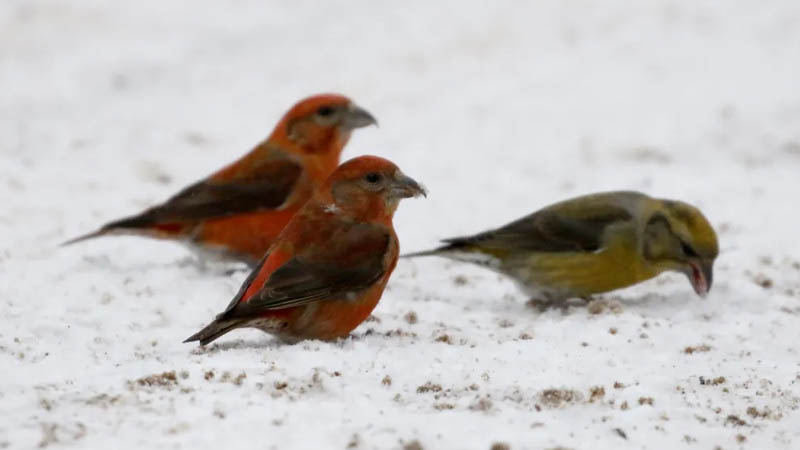
Type 12 Blog written by Ryan Mandelbaum: https://finchnetwork.org/type-12-the-old-northeastern-red-crossbill
Published paper about Type 12: https://www.frontiersin.org/journals/bird-science/articles/10.3389/fbirs.2024.1363995/full
Type 12 has been something in the works for close to 10 years, and the theme by some in recent years has been, “why don’t you describe it already, we know it looks and sounds different”. So to some this is overdue. Thanks for staying patient.
Also, we have been asking many the last 3-5 years to add “eastern Type 10” in the comments. We have been cleaning these records up the best possible inrecent weeks and to the people that that added “eastern Type 10” in the comments, we’d like to say it has been very helpful. Thanks again!
As mentioned above, more will follow in the coming weeks, but Type 12 (formerly “eastern type 10”) mainly only occurs in the Northeast as seen here in the eBird map.
As for Type 10, that is largely a Pacific Northwest bird, with a few likely coming east in the larger Type 3 irruptions that occur approximately every 3-5 years. Type 10 eBird map can be seen here.
If you click on checklists with audio recordings you can get the basic gist of the differences in sound and look of the spectrogram between the 2 call types. One goes up in frequency and one goes up and back down. We are still cleaning up some records. See near bottom of page for more.
Appearance
Medium-sized finch red (males) to yellow (females) finch with distinctive mandibles curved and crossed at the tip.
Size: L 5.5–7.8″
Shape: Fairly small, short-tailed, short-legged, big-headed, broad-necked bird with distinctive heavy bill with crossed tips. Tail deeply notched; primary projection very long (21⁄2 x bill).
Both Sexes: Lack bold white wingbars of White-winged Crossbill.
Adult Male: Body mostly all red, orangey, or even yellow, sometimes a mix of red and yellowish feathers; wings and tail blackish; throat and breast usually of uniform color.
Adult Female: Brownish or yellowish or yellowish green, often brightest on rump, crown, and breast; throat always grayish and lacking color, which is the best way to tell females from younger males; rarely may have thin, indistinct, buffy or grayish wingbar on coverts (but never like a broad, well-defined, white wingbar of White- winged Crossbill, which also has white-tipped tertials). In both sexes, undertail coverts whitish with dark chevrons.
1st Year: M. may be yellow, orange, or reddish with some brown; f. usually brownish or greenish with a little yellow but no color on the throat, as with adult f.
Juv: (just about any time of year since crossbills breed almost year-round) Brownish overall, with heavy brown streaking on whitish underparts; sometimes thin buffy wingbars. May breed in this plumage.
Irruptions:
Natural History
Ecotypes live in core areas of occurrence with the conifers they primarily feed on their key conifers. While almost all call types can feed on a variety of conifers, and they do, bill differences, like a tight fit of tool to the task, make many crossbill tribes uniquely suited for efficiently extracting the seeds of the key conifers in their core area.
Taxonomy
Jeffrey Groth’s 1993 landmark study and monograph of call types was a key advancement in the science of the Red Crossbill.2 It demonstrated that rather
than thinking of Red Crossbills in terms of subspecies, their differences in bill and body size should be categorized by their contact flight call. He first described 8
call types, and in 1999, Craig W. Benkman found Call Type 9 in two isolated Idaho mountain ranges.3 That type was elevated to species status—the Cassia Cross- bill—in 2017. Kenneth Irwin distinguished Call Type 10 in 2010,4 and a crossbill found mainly in Middle America was designated as Type 11.5 The newest call type is Type
12 (formerly the eastern Type 10), described by Matthew A. Young et al. in 2024,6 and is most common in the Great Lakes, Northeast, and Maritimes. Not counting Type 9 (Cassia), owing to its elevation to species status, there are now 11 call types in North and Central America.
The vast majority of the call types occasionally overlap in range even when breeding, violating the basic principle of subspecific designation, in which breeding ranges must be largely non-overlapping geographically. However, a few subspe- cies at the periphery of the range may be accurately assigned to subspecies: L. c. stricklandi (Type 6) in Arizona into Mexico, L. c. mesamericana (Type 11) in Central America, and L. c. percna (Type 8) in Newfoundland. L. c. neogaea is a match for one of the types most commonly found in eastern North America, likely Type 12, the new “Northeastern Crossbill.”
Object of study
Call types identifications, call recognition model, assortative mating, and distributions.
Known Flight Call types of North American Red Crossbills
(Spectrograms prepared by Andrew Spencer)

Spectrograms of the Call Types.
Type 1 – Appalachian Crossbill (Young et al. 2011) — Medium-billed
Natural History
Is found primarily in the Appalachians from s. New York to Georgia and even Alabama; occasional in Adirondack Mts., NY, and central Massachusetts northward into New England, s. Ontario, Maritimes, and perhaps Great Lakes; rare to very rare in West. Appears to be more of a generalist than most call types but is most closely associated with Red Spruce and White Spruce, Eastern White Pine, and hard-coned pines such as Pitch, Red, Virginia, and Loblolly in east; in the West has used Sitka Spruce and Western Hemlock. Flight call is described as a hard, quick, attenuated chewt-chewt similar to the chip of a Kentucky Warbler; compare to the softer Type 2.

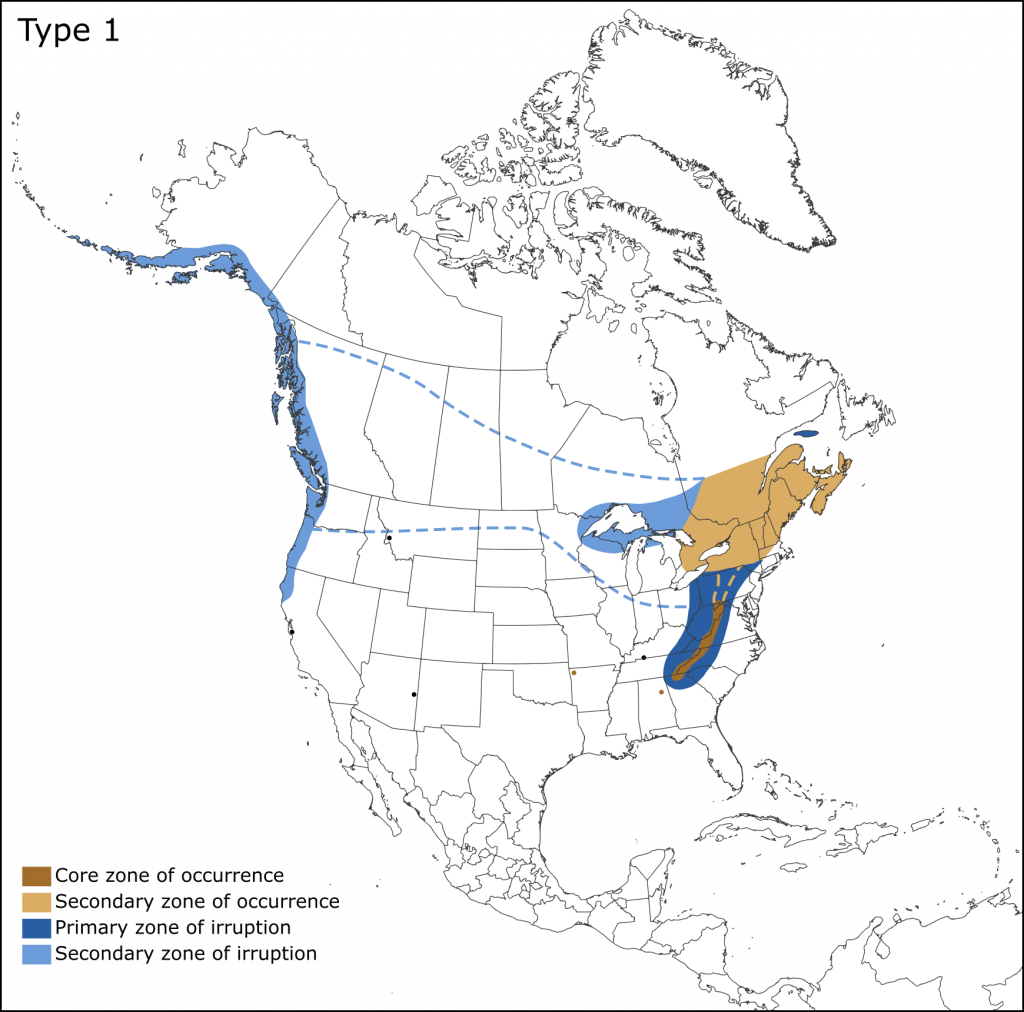
For more on Type 1 see here:
https://ebird.org/news/crossbills-of-north-america-species-and-red-crossbill-call-types/
http://aba.org/blog_docs/Type1RedCrossbill-NAB.pdf
Type 2 – Ponderosa Pine Crossbill (Benkman 2007) — Large-billed
Natural History
Most common in the Ponderosa Pine forests of the West, but can be found continentwide in U.S. and into very n. Mexico and parts of s. Canada. Moderately irruptive and can occur nearly anywhere, but occasionally in numbers to the Great Lakes and rarely even into the Plains states. Most efficient at feeding on Ponderosa Pine in the Intermontane West, but will use other hard pines as well, including Lodgepole and Jeffrey pines (West), Red, Jack, Pitch, Virginia and Table Mountain Pines (East). Uses spruces and soft-coned pines as well. Very eclectic in diet. Sounds similar to Type 1, but a husky, deeper and lower choowp-choowp or chew-chew; can recall Pygmy Nuthatch or Olive-sided Flycatcher’s pip-pip-pip. Western birds sound a bit more “ringing” or even squeaky in quality, as compared to eastern birds. Compare squeaky sounding birds to Type 3.

Type2_flight_call_kinked_ML 44960 (middle and on right above)
Type2_flight_call_unkinked_ML 1612991 (left above)
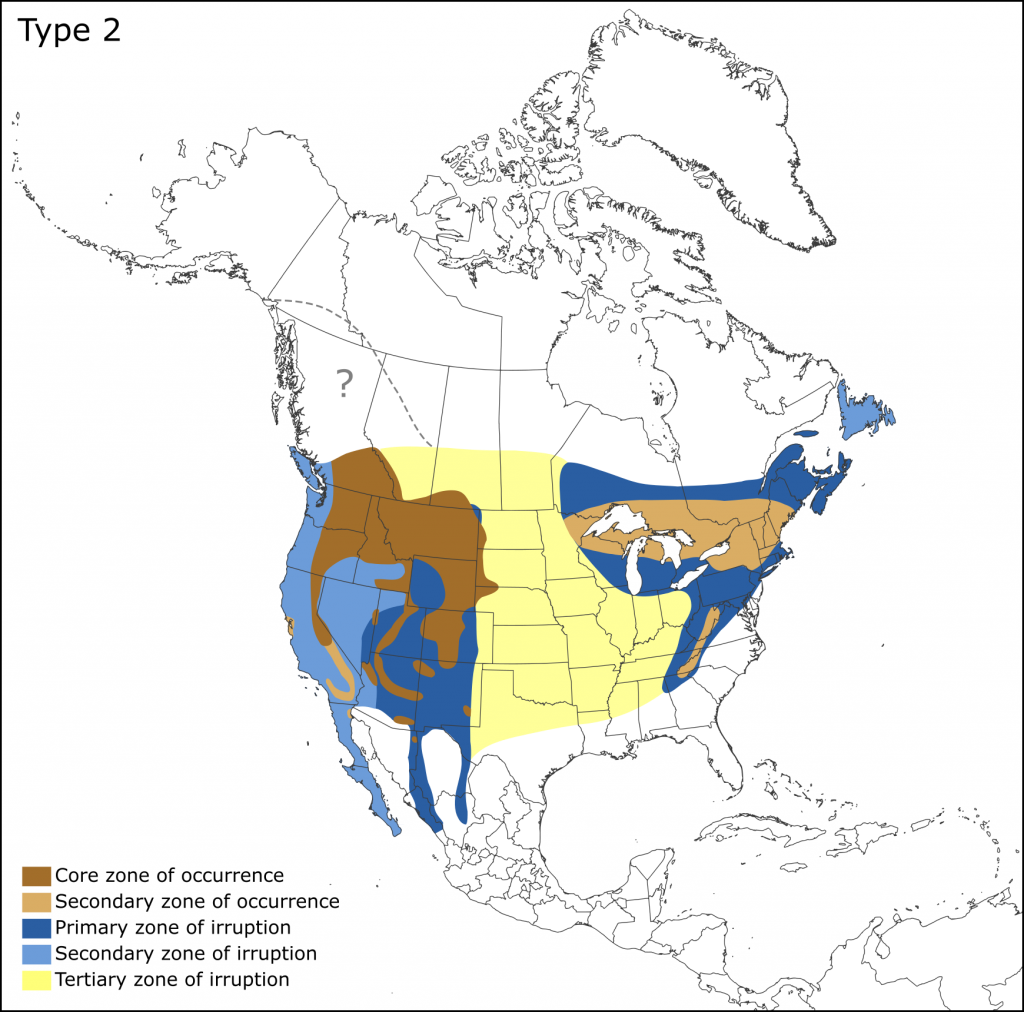
For more on Type 2 see here:
https://ebird.org/news/crossbills-of-north-america-species-and-red-crossbill-call-types/
Type 3 – Western Hemlock Crossbill (Benkman 2007) — Small-billed
Natural History
Primarily in the northern coastal areas of western North America, but can be found in numbers to Great Lakes into northeast, Ontario and Maritimes every 2-5 years. Highly irruptive into the Great Lakes, Northeast, Ontario and likely Maritimes every 2-5 years in numbers. Most common in areas of Western Hemlock but uses Engelmann and Sitka spruce, and less often Douglas-fir and Blue Spruce in the West; in the East, most often uses Eastern Hemlock or White and Red spruces. A squeaky or scratchy tik-tik or kyip-kyip; highly distinctive.

Type3_flight_call_ML 136592 (now in ML as ML71525571, despite file names here)
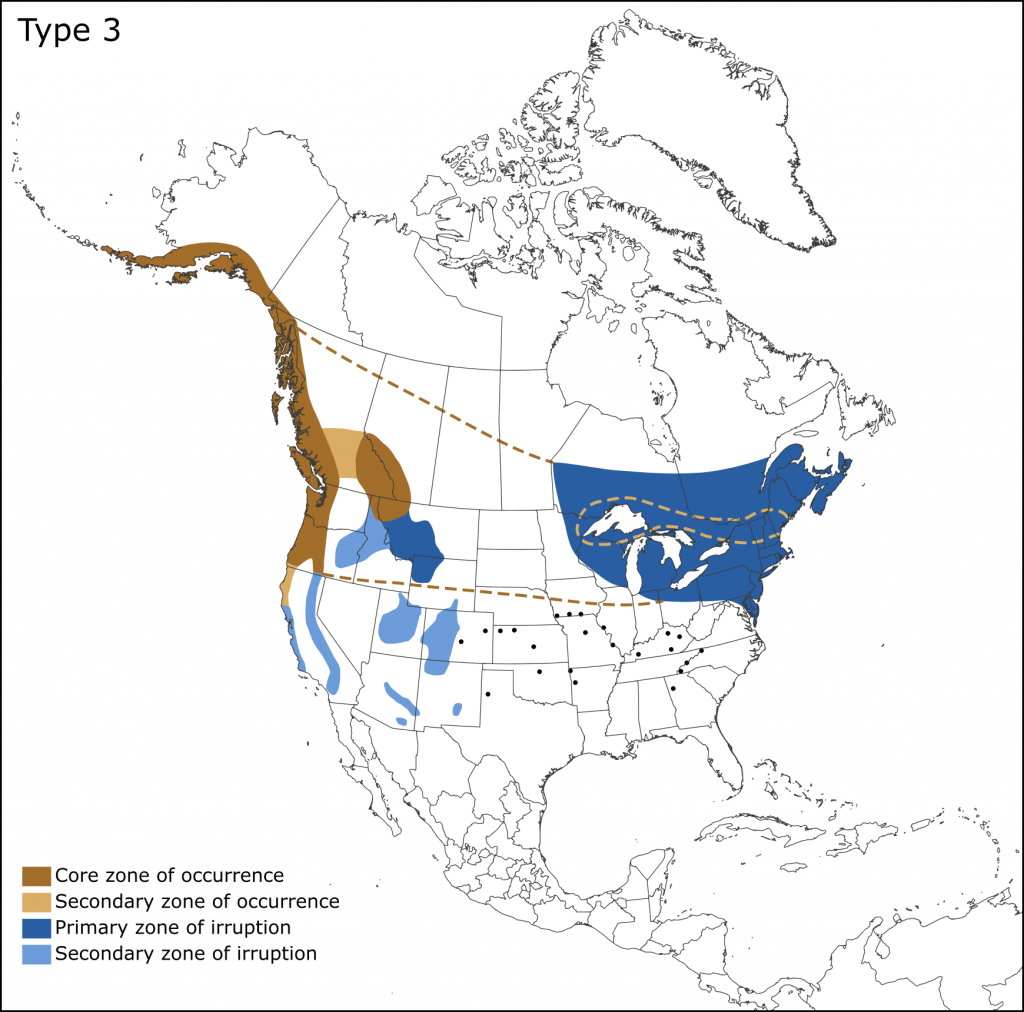
For more on Type 3 see here:
https://ebird.org/news/crossbills-of-north-america-species-and-red-crossbill-call-types/
Type 4 — Douglas-fir Crossbill (Benkman 2007) — Medium-billed
Natural History
Most common in coastal variety of Douglas-fir; less often uses interior variety of Douglas-fir; also uses various spruces and red and white pines when it moves eastward. Occasionally irrupts to Intermontane West and Great Lakes, and rarely to Northeast. Flight call sounds like a bouncy plick-plick-plick or pwit-pwit-pwit; very distinctive, but compare to Type 10 and 6.

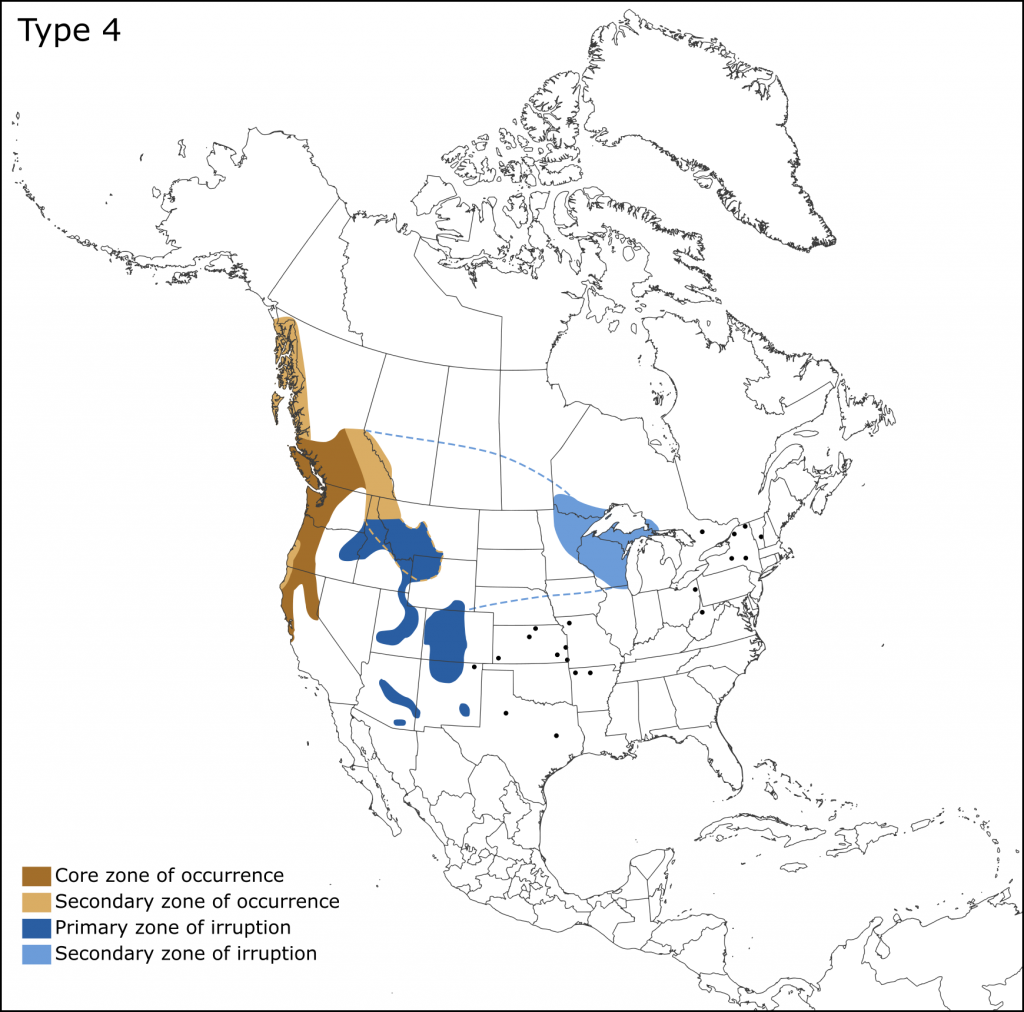
For more on Type 4 see here:
https://ebird.org/news/crossbills-of-north-america-species-and-red-crossbill-call-types/
Type 5 – Lodgepole Pine Crossbill (Benkman 2007) — Large-billed
Natural History
Western in U.S. and Canada; vagrant to the Great Lakes and Northeast. Occasionally irruptive in parts of the Intermontane West. Most common in Lodgepole Pine and Engelmann Spruce, less often uses Douglas Fir, Blue Spruce or white pines. Sound is like a springy or twangy clip-clip-clip or chit-chit-chit; quite distinctive and level sounding.

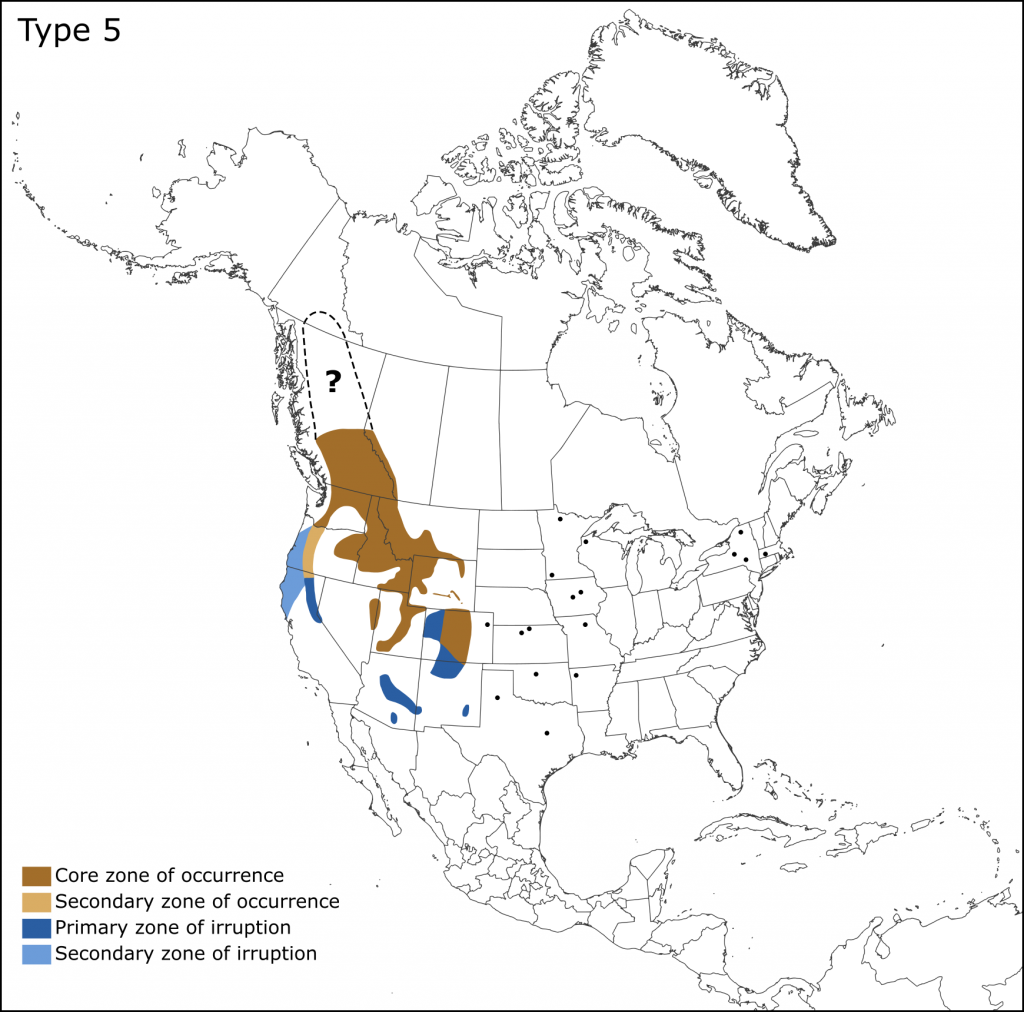
For more on Type 5 see here:
https://ebird.org/news/crossbills-of-north-america-species-and-red-crossbill-call-types/
http://aba.org/blog_docs/Type5RedCrossbill-NAB.pdf
Type 6 – Sierra Madre Crossbill (Benkman 2007) — Large-billed
Natural History
In the U.S. it occurs in se. Arizona and sw. New Mexico and museum specimens have been noted from Colorado and California. Occurs to southern Mexico and south to Guatemala and El Salvador. Some years perhaps more common in Arizona than others. Feeds on several hard-coned pine species of Mexico, especially Apache Pine. Flight call sounds like a cheep-cheep, ringing, and tonal. Compare with type 4.

Type 6 flight call aF743 (The Museum of Vertebrate Zoology at Berkeley)
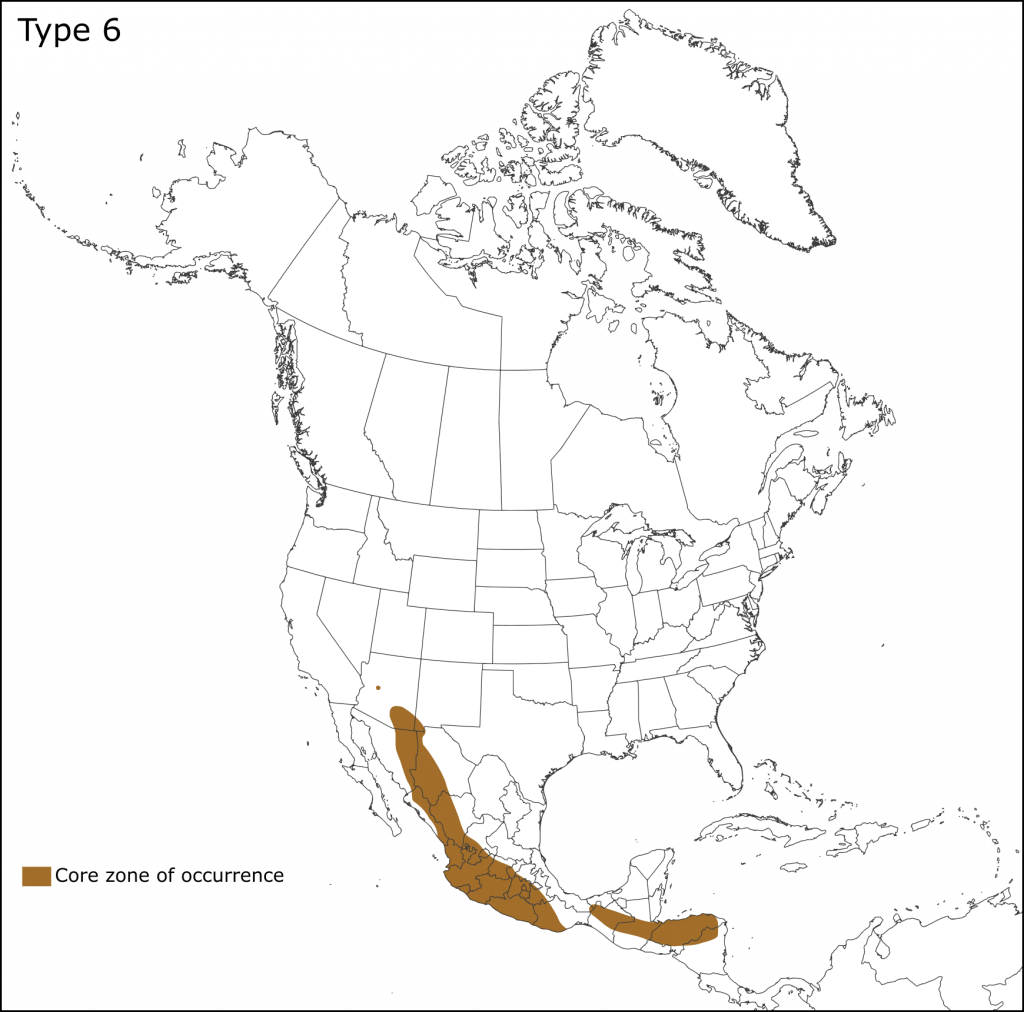
For more on Type 6 see here:
https://ebird.org/news/crossbills-of-north-america-species-and-red-crossbill-call-types/
Type 7 – Enigmatic Crossbill — Medium-billed to large-billed (Young 2012).
Natural History
Core zone of occurrence is likely Eastern British Columbia, western Alberta north to southern Yukon territory and south to northern Colorado and California. This is among the rarest crossbilly types in North America, with only a few handfuls of diagnostic recordings.
Perhaps similar to Cassia and Type 5, but more north. Unknown whether more of a key conifer type or more of conifer switcher to other rich patches of conifers. More study needed. Unknown, but likely Lodgepole Pine north of the range of Type 5 and Cassia, but if above is true, very well could be a bit more of a generalist that uses Lodgepole Pine and Engelmann, White and “Hybrid Spruce” where the two species overlap.
Husky jit-jit-jit somewhat intermediate in sound between Type 2, 5 and Cassia. Some rare Type 12 can sound similar as well. Type 7 is the flight call type that needs the most recordings (and measurements of the same audio-recorded individuals) in order to pin down flight call variability and geographic distribution.

Museum of Vertebrate Zoology, Berkeley Type 7_flight_call_aF497
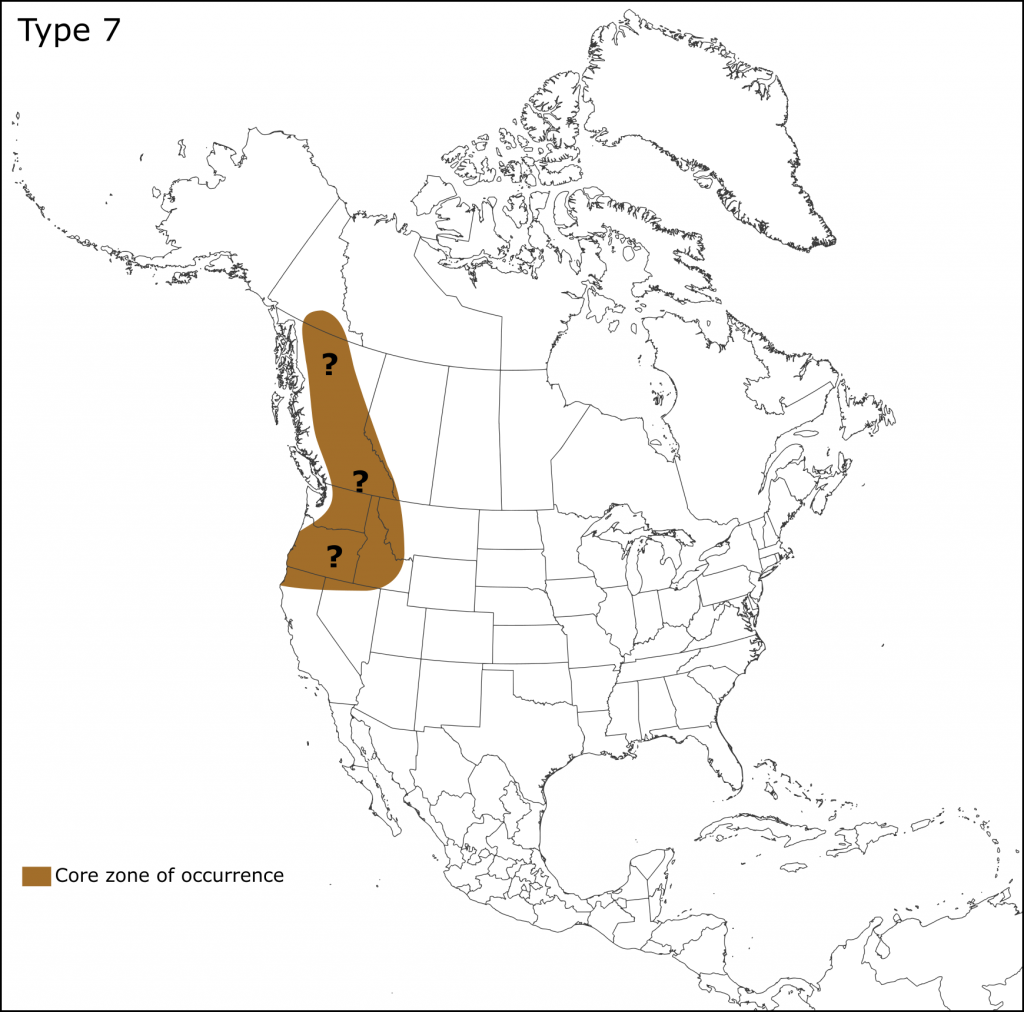
Type 8 – Newfoundland Crossbill (Griscom 1937) — Large-billed
Natural History
Listed as Threatened by the Canadian Wildlife Service. Thought to be resident to island of Newfoundland, but at least rarely moves to Anticosti Island, Quebec; perhaps moves to Magdalen Islands, Quebec, or other nearby Maritime coasts as well. Likely associates with spruces and pines. Flight call sounds like Cheet-cheet, ringing and complexly modulated.

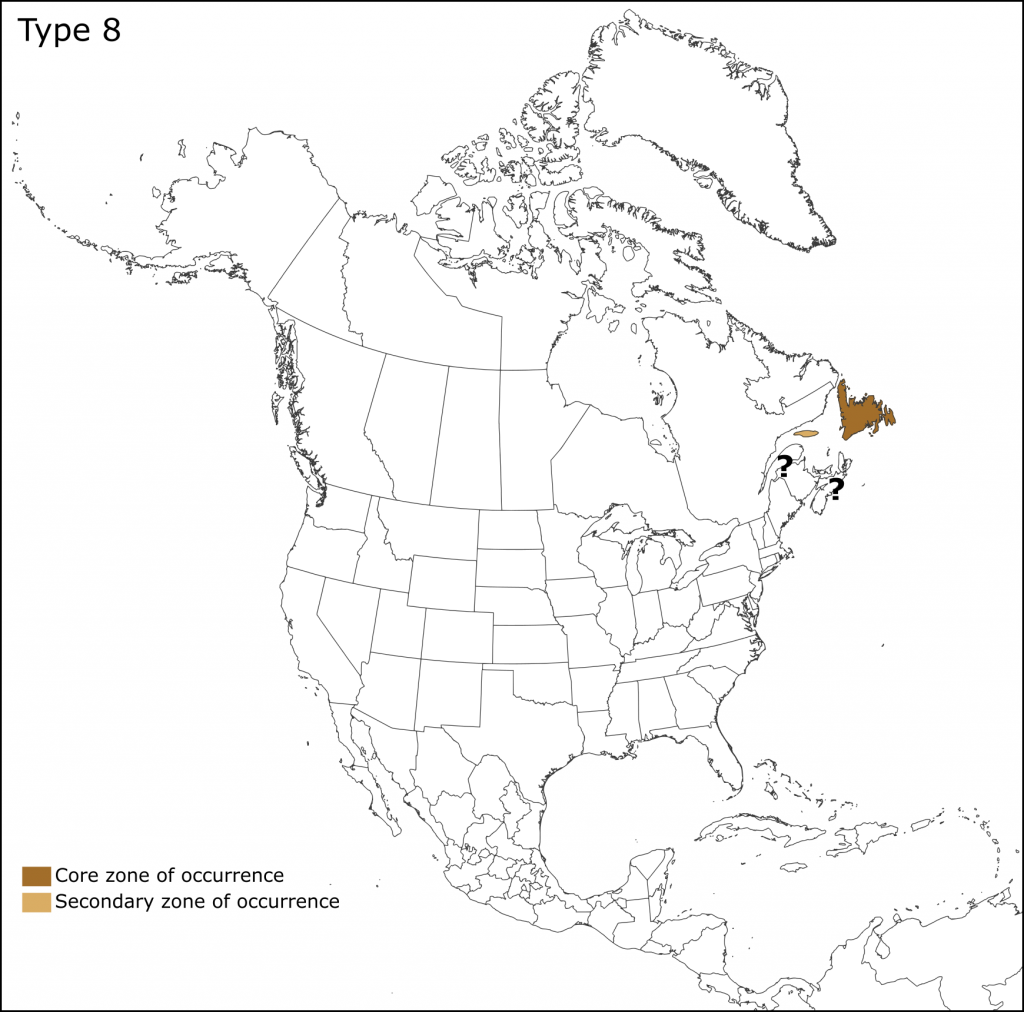
For more on Type 8 see here:
https://ebird.org/news/crossbills-of-north-america-species-and-red-crossbill-call-types/
http://aba.org/blog_docs/Newfoundland_Crossbills_NAB_66-1_pp16-67.pdf
http://www.ace-eco.org/vol13/iss1/art10/
Cassia Crossbill (Benkman et al. 2009)
— Large-billed (formerly Type 9)
Natural History
Core Zone of Occurrence largely restricted to South Hills and Albion Mountains of southern Idaho, in Twin Falls and Cassia Counties only [eBird map], but there are now several records from Colorado, Wyoming, and California.
Apparently resident, but may rarely wander to mountains to northeast of South Hills (Benkman et al. 2009). Uses local variety of Lodgepole Pine that has evolved in absence of cone-predating pine squirrels. Very dry dip-dip-dip or dyip-dyip-dyip; very distinctive.

Cassia Crossbill_flight_call_64374391
Cassia Crossbill_flight_call_65163941
Type 10 – Sitka Spruce Crossbill (Irwin 2010) – Small-billed to medium-billed
Natural History
Core zone of occurrence primarily the narrow fog belt less than 10 miles from the Pacific Coast from Vancouver Island, British Columbia to Central California, but occasional irrupts into the east in movements which are not yet well described. There are also a few records north to the Kenai Peninsula of Alaska.
More of a key conifer type strategy and often one of the more non-migratory types, with birds very rare even 5-10 miles inland from the coast in the Pacific Northwest. However, birds matching this type have been recorded occasionally in the East, and their origin warrants further investigation. They seem less common on the outer Pacific coast this year, and a few birds here and there have shown up in the east for the first time in years.
Displays a consistent and obligatory preference for Sitka Spruce in the Pacific Northwest (Centanni et al., 2024), but rarely has been seen feeding in Douglas Fir and Western Hemlock? Uses Spruces and Pines in rare eastward irruptions and was confirmed nesting in late winter-spring in jack and red Pine in Wisconsin irruption 2017-18. Very dry thin whit-whit; recalls Empidonax flycatcher whit note; very distinctive. Compare with Types 4 and 12.

Type 10_flight_call_ML68288161
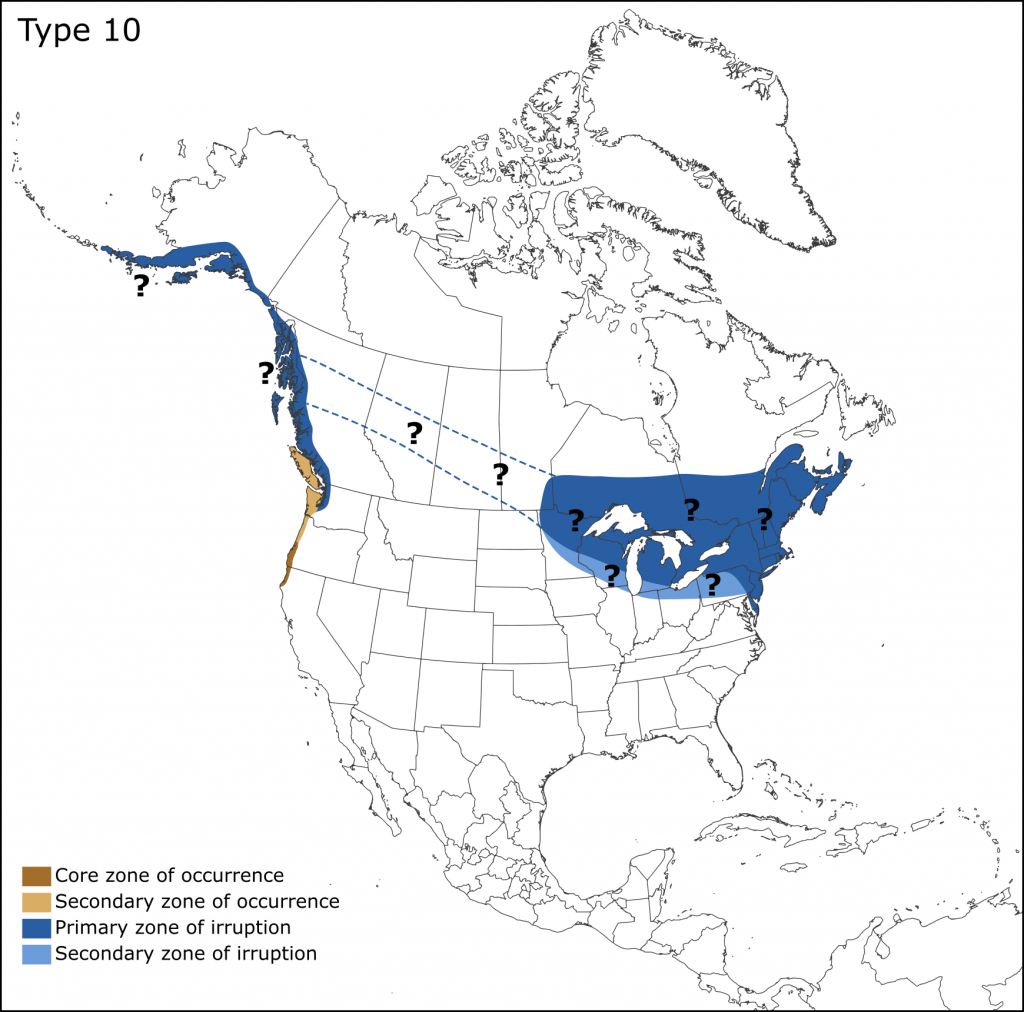
For more on Type 10 see here:
https://ebird.org/news/crossbills-of-north-america-species-and-red-crossbill-call-types/
Type 11 – Central American Crossbill (Young and Spahr 2017) — Large-billed
Natural History
Guatemala, Honduras, Belize, Nicaragua, and El Salvador (recordings needed); appears to most closely associated with hard-coned pine species of Central America, most specifically Mexican Yellow Pine Pinus
oocarpa (pers. comm. John van Dort). Gives a flat, polyphonic flight call that can sound similar to the Cassia Crossbill or some lower-frequency variants of Type 5. It could be represented by drip-drip-drip, and sounds very different than the slightly ringing quality heard in the Type 6 birds with which it shares habitat.


For more on Type 11 see here:
https://ebird.org/news/crossbills-of-north-america-species-and-red-crossbill-call-types/
Type 12 – Northeastern Crossbill (Young et al. 2024) – Small-billed to medium-billed
Core range of occurrence is the northeastern cordillera of North America, with occurrence common in the Adirondacks, New England and Maritime coastal zone. Fairly common but in lower numbers across the Great Lakes and rare south along the coast to Maryland and rarely North Carolina. Extremely rare in the west, but records for Idaho, Oregon, British Columbia, Alberta, Alaska, and California have been documented since 2017.
Likely a generalist rich patch exploiter or conifer switcher on a more regional landscape level than types 2, 3 and 4. Small scale Irruptions within the east are often every other year, with flocks typically making coastal movements to pursue the best cone crops. In some years, birds move further afield south along the Atlantic Coast, and rarely to Appalachians where it rarely overlaps with the much more mountain Interior (Appalachians) Type 1.
Trees Most Closely Associated with Generally associated with Red Spruce and sometimes White Spruce along the northeastern coast and Adirondacks. Also uses many pines, especially Eastern White Pine. Red Pine, Pitch Pine, Jack Pine and Japanese Black Pine are also regularly used. Will frequently uses planted Norway Spruces in big crops years as well.
Overslurred Type 12 (formerly over- slurred / western Type 10) gives a harder, squeakier kip-kip with a strong downward inflection at the end, looking like an upside down V. Rarely can approach Type 1 and can be challenging to identify much likely Type 1 and 2.
Flight call begins with a moderately long rising element followed by a very steep decline, perhaps the most vertical drop of any crossbill flight call. Due to the long initial upward element, which is quite similar to Type 10 flight calls, this type was originally lumped with that species. Sometimes calls can be a bit more overslurred, and these recordings can approach type 1. The steep decline gives it both a distinctive appearance on sonograms and a fairly different tone from Type 10, however, like with type 10, the majority of the energy of the call is given in the upward component. When identifying Type 12 from Type 1 and eastern (“unkinked”) Type 2, consider Type 2s generally have a much shallower slope and typically no sign of an initial upsweep and Type 1s may have a small initial uptick or hook at beginning, but the upsweep is long, steep and noticeable on most all Type 12 . In good recordings, Type 1 is also typically poloyphonic with secondary elements whereas Type 2 and 10 do not have these elements.

Museum of Vertebrate Zoology, Berkeley Type 12_flight call_jM498
Type 12 Foraging Chart from Stokes Guide to Finches of United States and Canada (for more of these please see book)




